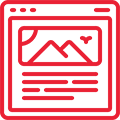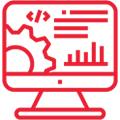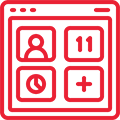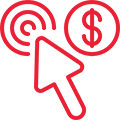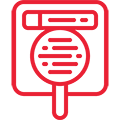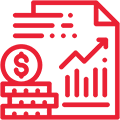“NEWMEDIA not only met, but greatly exceeded our goals for the project. They were incredibly responsive, quick to offer great solutions, and brought expertise we didn’t have. Their ability to think outside the box and create beautiful experiences for our customers is incredible.“
Top Web Design Company
NEWMEDIA.COM for Professional Web Design
NEWMEDIA.COM builds websites that combine modern design, strong functionality, and seamless user experiences to help businesses grow online. Our team creates mobile-ready, SEO-friendly sites that load quickly, look professional, and guide visitors toward meaningful actions. Every website is planned with your business goals in mind, ensuring it attracts the right audience and supports long-term success.
We handle the entire process, from layout planning and design to development, optimization, and ongoing support. With a focus on performance, usability, and measurable results, NEWMEDIA.COM delivers websites built for visibility, engagement, and real business impact.
Our Web Design Process
Market and Competitor Analysis
We begin with a detailed analysis of your industry, audience, and competitors to uncover the best opportunities for design, functionality, and user experience. Our research ensures your website meets both business goals and user expectations for long-term success.
Goal-Focused Website Strategies
Each web design project is tailored to your objectives, focusing on usability, SEO performance, mobile responsiveness, and conversion-focused layouts. We align every step with measurable outcomes so your site supports growth and engagement.
Design, Development, and Optimization
Our team handles the complete web design and development process, starting with wireframes and prototypes to map out user journeys. We create custom layouts tailored to your brand, integrate essential tools and plugins, and optimize for speed, security, and SEO readiness.
Reporting and Insights
We provide detailed reports that go beyond surface metrics, giving you insights into traffic sources, user engagement patterns, conversion rates, and site performance. Our reporting ensures you can see exactly how your website supports lead generation, sales, and overall business growth, making it easy to measure ROI and identify future opportunities for improvement.
Case Studies
What’s Included in Our Web Design Services
Custom Design and Layout Planning
We start with a collaborative design process where our team creates layouts tailored to your brand identity, audience needs, and business goals. From homepage wireframes to inner page templates, every element is designed for usability, aesthetics, and conversions. We ensure the site structure guides visitors toward the most important actions naturally.
UX and Conversion Optimization
A good-looking website only matters if it converts visitors into customers. We add clear calls to action, simplified navigation paths, and intuitive user flows to reduce friction and increase engagement. Our design approach encourages visitors to explore your site and take the next step toward conversion.
Ongoing Support and Maintenance
Our team provides regular updates for site software, themes, and core files to prevent vulnerabilities and maintain compatibility with the latest technology. We monitor performance closely, run security checks, resolve issues quickly, and keep speed optimized as your content and traffic grow.
Content Structure and Page Development
We organize and develop content to improve user experience and SEO performance. Our team builds optimized landing pages, service sections, blog templates, and product or portfolio pages. Each page communicates clearly, keeps branding consistent, and engages users at every stage of their journey.
Technical Web Foundations
A strong technical base is essential for success. We build websites with clean code, SEO-friendly structures, and mobile-first designs. Our team manages page speed optimization, security features, plugin integrations, and hosting recommendations to ensure your site runs smoothly on all devices.
Performance Tracking and Reporting
We set up analytics and tracking tools to monitor traffic, user behavior, engagement, and conversions. Reports give you a clear view of how your website supports lead generation, sales, and overall business growth. These insights help identify improvement opportunities and guide future strategy.
See Our Portfolio
Molly Hall Dorais
Colorado Rocky Mountain School
Get a website designed to attract visitors and drive conversions. Request your proposal for pricing and a growth plan.
Get A free ProposalWhy Businesses Choose Our Web Design Services
Companies choose us when they need websites that look professional and perform seamlessly. We combine modern design, strong functionality, and a user-friendly experience to create websites that attract visitors and turn them into customers.
Clients stay because our web design services deliver consistent results, clear reporting, and a measurable impact on business growth. With our team managing design and optimization, businesses can focus on their operations while we ensure their website drives real results.
What Customers Say About Us
Randall T.
Talk to our team for clear pricing and a design strategy built to drive engagement, conversions, and growth.
Speak to Our TeamRelated Services
Request a personalized web design proposal with a clear strategy and pricing plan for your business goals.
Request A Proposal